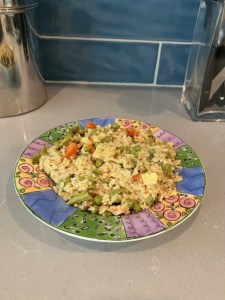Eggs, peanut butter and beans traditionally have been an affordable source of protein.
They are high in nutrition and low in price, so families have relied on these as a protein option that’s more affordable than meat.
But egg prices have been in the news lately — with volatility in prices that’s been noticeable at the grocery store.
In early March, I noticed quite a price range at Aldi.

One weekend, a dozen was $2.31 — cue the excitement that the price was finally coming down. Then, the following weekend, it was $4.91 a dozen — cue the disappointment.
Now that we’re in April, I thought I would ask my coworker, who works in livestock and agriculture, what exactly happened and what we can expect going forward.
She shared these insights.
Egg prices have created quite a bit of sticker shock at the grocery store during the past year.
Egg prices in 2022 were up 138% for the year.
Agricultural economists explain that it’s a supply and demand issue.
Egg production has been reduced, with the avian influenza (HPAI – highly pathogenic avian influenza) cited as the major source for the reduction.
This highly contagious disease is carried by wild birds from place to place.
Wild birds often show no signs of the disease; domesticated birds, such as commercial turkeys and chickens, are highly affected.
The best practice for commercial poultry producers is to follow very strict biosecurity protocols.
This includes disinfection of shoes and equipment coming into poultry houses; no visitors in barns; and securing barns and feed storage areas to prevent wild animals from having access.
More than 50 million birds were lost in 2022 due to the disease — which requires flocks to be depopulated (slaughtered) to prevent further spread of the virus.
There was a “perfect storm” over the holidays — a large drop in egg supply due to significant farm depopulation in the fall matched with larger demand during the holiday baking season.
Inflation also impacts production costs for farmers.
Egg producers are faced with higher feed costs, while at the same time they’re paying more for fuel to transport eggs and operate their farms.
There may be some bright news in sight, however.
The U.S. Department of Agriculture expects that wholesale egg prices will decline this year.
According to the Bureau of Labor Statistics, the food index for eggs fell 6.7% in February.
The drop in egg prices will depend on how much flock depopulation occurs and how quickly farms can recover.
It requires a little more than 20 weeks for hens to lay eggs from the day they are hatched, so it takes a bit of time for egg supply to stabilize.
Meanwhile, chicken for meat consumption hasn’t seen such price hikes.
These chickens, called broilers, don’t have as long of a life cycle (only about 5.5 weeks to 9 weeks, versus 2 years to 3 years for egg producers).
This shorter life span gives the virus less time to spread.
Plus, broilers are of a different breed, which happens to be less susceptible to the virus.
There were some impacts, and price fluctuations, caused by the avian flu, but to a lesser extent.
At the end of the day, if eggs cost $4 per dozen, each egg costs 33 cents.
So, eggs are still a bargain for a high-quality, nutrient-dense food, including protein, vitamin B12, biotin, iodine, selenium, choline, riboflavin (vitamin B2), pantothenic acid (vitamin B5) all 9 essential amino acids, and more.
As for the cholesterol? Yes, you will find cholesterol in eggs.
But recent research has found that dietary cholesterol (such as from egg yolks) doesn’t have much influence on total blood cholesterol; instead, it’s the saturated fat and trans fat that has more influence.
Most cholesterol comes from our liver, not from our diet.
Saturated fat in the diet can cause your liver to make excess cholesterol, according to Harvard Health Publishing.
It’s still a good idea, though, to practice moderation. The average healthy person can have up to seven eggs per week without any harmful effects, but of course, keep in mind your overall diet and how much saturated fat you consume.
Those with heart disease should limit egg consumption to just a few per week.
There are various ways to prepare eggs, of course and they can make a good ingredient in various dishes — such as fried rice, for example. Here’s a recipe for you to try, from MyPlate.gov.
Shari Bresin is the Family & Consumer Science Agent for the University of Florida/Institute of Food and Agricultural Sciences Cooperative Extension Pasco County. Pasco County Extension Laura Bennett, Livestock Agent for Pasco County Extension contributed to this column.
RECIPE
Egg Fried Rice
Ingredients
- 1 Tablespoon vegetable oil
- 2 eggs (beaten)
- 3 1/2 cups brown rice, cooked (or white rice)
- 1 cup chicken breast, ham or pork, cooked (and chopped)
- 1 cup mixed vegetables, cooked (and chopped)
- 2 green onion (sliced)
- soy sauce or hot sauce (optional, to taste)
Directions
- Wash hands with soap and water.
- Heat pan. Add 1 teaspoon of oil. Add eggs and scramble.
- Remove cooked eggs and set aside.
- Add the rest of oil (2 teaspoons) to the pan. Stir-fry (cooked) rice, breaking up lumps by pressing rice against the pan.
- Add cooked meat and/or vegetables. Stir-fry until heated.
- Add green onions, reserved eggs and sauce to taste. Serve hot.
- Cover and refrigerate leftovers within 2 hours.
Published April 12, 2023